An alternate method, if you're interested, using the same example as above:
library(DECIPHER)
ProtDF <- c(OQS54945.1 = "MINDLKVRKDVEKSKAHCHVKPFGKGSRACERCASHRGHNRKYGMNLCRRCLHTNAKILGFTSFD",
XP_031008245.1 = "KHTESPVEPARRDNLKTAIMSHESVWNSRPRTYGKGARACRVCTHKAGLIRKYGLNICRQCFREKASDIGFVKVCDGHTDSSYDGSEF",
TVY80688.1 = "MSHESVWNSRPRTYGKGARACRVCTHKAGLIRKYGLNICRQCFREKAADIGFVKHR",
TVY57447.1 = "LPFLKIRVEPARRDNLKPAIMSHESVWNSRPRTYGKGARACRVCTHKAGLIRKYGLNICRQCFREKASDIGFVKVCVDAMGTLEPRASSPEL",
TVY47820.1 = "EPARRDNLKTTIMSHESVWNSRPRTYGKGARACRVCTHKAGLIRKYGLNICRQCFREKAADIGFVK",
TVY37154.1 = "AISKLNSRPQRPISTTPRKAKHTKSLVEPARRDNLKTAIMSHESVWNSRPRTYGKGARACRVCTHKAGLIRKYGLNICRQCFREKASDIGFVKHR",
TVY29458.1 = "KHTESPVEPARRDNLKTAIMSHESVWNSRPRTYGKGARACRVCTHKAGLIRKYGLNICRQCFREKASDIGFVKVCDGHTDSSYDGSEF",
TVY14147.1 = "MSHESVWNSRPRTYGKGARACRVCTHKAGLIRKYGLNICRQCFREKASDIGFVKVCDGWIGTLEL",
`sp|Q6CPG3.1|RS29_KLULA` = "MAHENVWYSHPRKFGKGSRQCRISGSHSGLIRKYGLNIDRQSFREKANDIGFYKYR",
`sp|Q8SS73.1|RS29_ENCCU` = "MSFEPSGPHSHRKPFGKGSRSCVSCYTFRGIIRKLMMCRRCFREYAGDIGFAIYD",
`sp|O74329.3|RS29_SCHPO` = "MAHENVWFSHPRKYGKGSRQCAHTGRRLGLIRKYGLNISRQSFREYANDIGFVKYR",
TPX23066.1 = "MTHESVFYSRPRNYGKGSRQCRVCAHKAGLIRKYGLLVCRQCFREKSQDIGFVKYR",
`sp|Q6FWE3.1|RS29_CANGA` = "MAHENVWFSHPRRFGKGSRQCRVCSSHTGLIRKYDLNICRQCFRERASDIGFNKYR",
`sp|Q6BY86.1|RS29_DEBHA` = "MAHESVWFSHPRNFGKGSRQCRVCSSHSGLIRKYDLNICRQCFRERASDIGFNKFR",
XP_028490553.1 = "MSHESVWNSRPRSYGKGSRSCRVCKHSAGLIRKYDLNLCRQCFREKAKDIGFNKFR")
# All pairwise alignments:
# Convert characters to an AA String Set
ProtDF <- AAStringSet(ProtDF)
# Initialize some outputs
AliMat <- matrix(data = list(),
ncol = length(ProtDF),
nrow = length(ProtDF))
DistMat <- matrix(data = 0,
ncol = length(ProtDF),
nrow = length(ProtDF))
# loop through the upper triangle of your matrix
for (m1 in seq_len(length(ProtDF) - 1L)) {
for (m2 in (m1 + 1L):length(ProtDF)) {
# Align each pair
AliMat[[m1, m2]] <- AlignSeqs(myXStringSet = ProtDF[c(m1, m2)],
verbose = FALSE)
# Assign a distance to each alignment, fill both triangles of the matrix
DistMat[m1, m2] <- DistMat[m2, m1] <- DistanceMatrix(myXStringSet = AliMat[[m1, m2]],
type = "dist", # return a single value
includeTerminalGaps = TRUE, # return a global distance
verbose = FALSE)
}
}
dimnames(DistMat) <- list(names(ProtDF),
names(ProtDF))
Dend01 <- IdClusters(myDistMatrix = DistMat,
method = "NJ",
type = "dendrogram",
showPlot = FALSE,
verbose = FALSE)
# A single multiple alignment:
AllAli <- AlignSeqs(myXStringSet = ProtDF,
verbose = FALSE)
AllDist <- DistanceMatrix(myXStringSet = AllAli,
type = "matrix",
verbose = FALSE,
includeTerminalGaps = TRUE)
Dend02 <- IdClusters(myDistMatrix = AllDist,
method = "NJ",
type = "dendrogram",
showPlot = FALSE,
verbose = FALSE)
Dend01, from all the pairwise alignments:

Dend02, from a single multiple alignment:

Finally, DECIPHER has a function for loading up your alignment in your browser just to look at it, which, if your alignments are huge, can be a bit of a mistake, but in this case (and in cases up to a few hundred short sequences) is just fine:
BrowseSeqs(AllAli)

A side note about BrowseSeqs, for some reason it doesn't behave well with Safari, but it plays just fine with Chrome. Sequences are displayed in the order in which they exist in the aligned string set.
EDIT: BrowseSeqs DOES play fine with safari directly, but it does have a weird issue with being incorporated with HTMLs knitted together with RMarkdown. Weird, but not applicable here.
Another big aside: All of the functions i've used have a processors argument, which is set to 1 by default, if you'd like to get greedy with your cores you can set it to NULL and it'll just grab everything available. If you're aligning very large string sets, this can be pretty useful, if you're doing trivially small things like this example, not so much.
combn is a great function and I use it all the time. However for these really simple set ups I like looping through the upper triangle, but that's just a personal preference.



